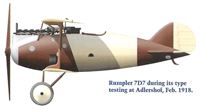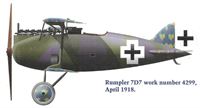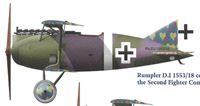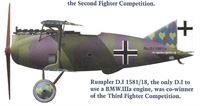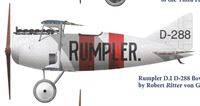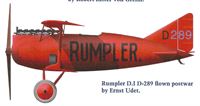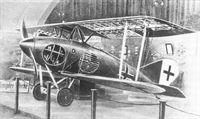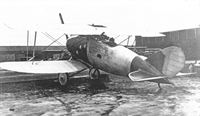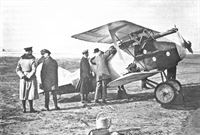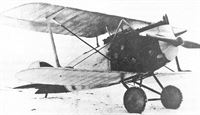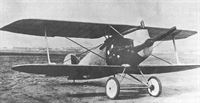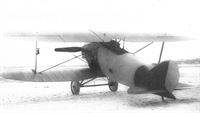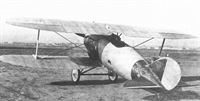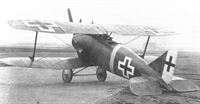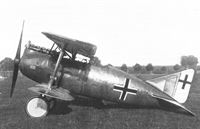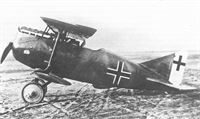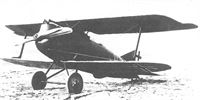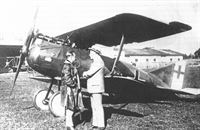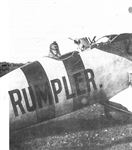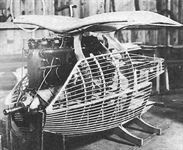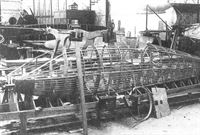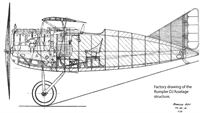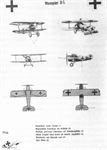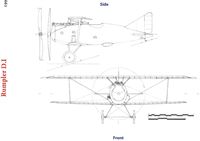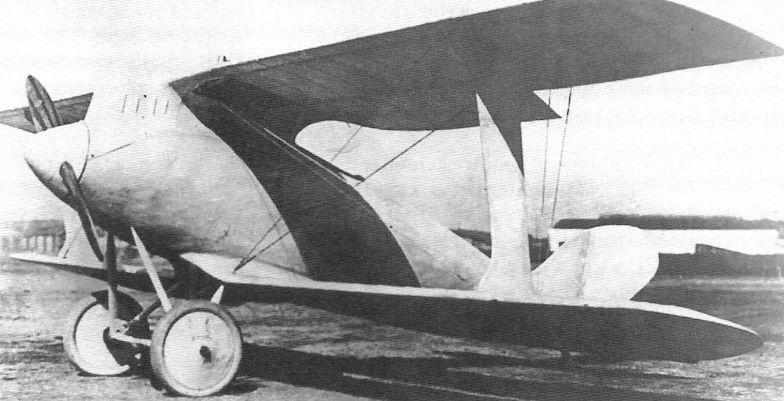
Описание
Страна: Германия
Год: 1917
Fighter
O.Thetford, P.Gray German Aircraft of the First World War (Putnam)
Rumpler 7D 1
This aircraft was the first of a series of experimental single-seat fighters which led eventually to the D I in 1918. The wooden, multi-stringered, streamlined fuselage was ply-skinned, then wrapped with doped fabric. The wings were orthodox, the upper wing being of parallel chord, the lower with a curved (dragonfly profile) trailing-edge. The engine was neatly cowled and combined with an extrusion of the fuselage to support the upper wing, which was not "gulled" as has been reported in the past. A flush radiator was mounted in the upper wing to port of the centre-line. Wide chord interplane struts of I-section braced the wing cellule. Engine, 160 h.p. Mercedes D III.
Rumpler 7D 2
Another prototype in the Rumpler D 1 evolution, the 7D 2 had the fuselage ply-skinned only fore and aft, the centre portion being simply fabric covered. It was also made deeper, and the lower wings built into it with smaller fairings. The upper wing, now with centrally mounted radiator, was supported on a more orthodox centre-section, found necessary to improve view from the cockpit. For this reason too the wide I-struts were replaced by more conventional twin struts. Engine, 160 h.p. Mercedes.
Rumpler 7D 4
Next development in this prototype series was the replacement of the twin interplane struts with single struts of "C" section in an endeavour to reduce drag. The radiators were now of the frontal "ear" type, placed low on the fuselage sides adjacent to the leading edge of the lower wings. They undoubtedly negatived any drag saving that had been effected by the revised wing-bracing system. Engine, 160 h.p. Mercedes. As far as can be ascertained, the 7D 5 did not differ visibly from the 7D 4.
Rumpler 7D 7
The Rumpler 7D 7, which followed a quadruplane project (7D 6), appeared to differ very little from the 7D 4, the only apparent variation being the encasement of the bracing cables in streamline casings. Engine fitted was now the more powerful 180 h.p. Mercedes D IIIa. Armament, twin Spandau machine-guns.
Rumpler D I (8D 1)
As may be seen, the eventual Rumpler D I did not differ markedly from its immediate prototypes. The introduction of balanced, overhung, ailerons may be noted; also the modification of the vertical tail surfaces to an exact triangular profile. The machine was said to have good flight characteristics except for sharp turns, when it too easily went into a spin. Two of these machines, 1552/18 and 1553/18, participated in the mid-summer D types Competition. Another, re-engined with the 185 h.p. B.M.W., took part in the third Competition in the autumn of 1918. Engine, 180 h.p. Mercedes IIIa. Span, 8.42 m. (27 ft. 7 1/2 in.). Length, 5.75 m. (18 ft. 10 3/8 in.). Height, 2.56 m. (8 ft. 4 3/4 in.). Area, 16 sq.m. (173 sq.ft.). Weights: Empty, 615 kg. (1,353 lb.). Loaded, 805 kg. (1,771 lb.). Speed, 180 km.hr. (112.5 m.p.h.) at 5,000 m. (16,400 ft.). Climb, 5,000 m. (16,400 ft.) in 26.5 min. and in 17.2 min. when fitted with high-compression engine. Duration, ca. 2 hr. Armament, twin Spandau machine-guns.
Описание:
- O.Thetford, P.Gray German Aircraft of the First World War (Putnam)
- W.Green, G.Swanborough The Complete Book of Fighters
- J.Herris Rumpler Aircraft of WWI (A Centennial Perspective on Great War Airplanes 11)
- M.Dusing German Aviation Industry in WWI. Volume 2 (A Centennial Perspective on Great War Airplanes 85)
Фотографии
-
J.Herris - Rumpler Aircraft of WWI /Centennial Perspective/ (11)
Rumpler 7D7 during its type testing at Adlershof, Feb. 1918.
-
J.Herris - Rumpler Aircraft of WWI /Centennial Perspective/ (11)
Rumpler 7D7 work number 4299, April 1918.
-
J.Herris - Rumpler Aircraft of WWI /Centennial Perspective/ (11)
Rumpler D.I 1553/18 competed the Second Fighter Competition.
-
J.Herris - Rumpler Aircraft of WWI /Centennial Perspective/ (11)
Rumpler D.I 1581/18, the only D.I to use a BMW.IIIa engine, was co-winner of the Third Fighter Competition.
-
J.Herris - Rumpler Aircraft of WWI /Centennial Perspective/ (11)
Rumpler D.I D-288 flown postwar by Robert Ritter von Greim.
-
J.Herris - Rumpler Aircraft of WWI /Centennial Perspective/ (11)
Rumpler D.I D-289 flown postwar by Ernst Udet.
-
J.Herris - Rumpler Aircraft of WWI /Centennial Perspective/ (11)
The Rumpler 7D1 prototype at Johannisthal in the spring of 1917 shows great attention to streamlining. Unfortunately, the engine cowling not only obscured the pilot's forward vision, it also interfered with the airflow from the propeller, preventing the engine from achieving its full RPM and thus its full power.
-
M.Dusing - German Aviation Industry in WWI. Volume 2 /Centennial Perspective/ (85)
The third variant was presented as Ru 7D3 in December 1918 at the Breslau Industrial Fair.
Seen being exhibited at Breslau in December 1918, the Rumpler 7D 3 flew in the summer of 1917. -
J.Herris - Rumpler Aircraft of WWI /Centennial Perspective/ (11)
The Rumpler 7D3 prototype was photographed in December 1918 at the Breslau Industrial Fair, for which it was repainted. Built in mid-1917, it had a conventional center section and parallel interplane struts.The cut-away skin on the fuselage reveals the original construction method was retained.
-
W.Green, G.Swanborough - The Complete Book of Fighters
The Rumpler 7D 4 with a twin-strut cellule which entered flight test in October 1917.
-
J.Herris - Rumpler Aircraft of WWI /Centennial Perspective/ (11)
Two Rumpler 7D4 fighter prototypes were tested at the First Fighter Competition; the parallel strut version shown. Both were powered by the Mercedes D.IIIa engine. Based on further research applied to the Rumpler C.IV, these had no propeller spinner. The nose and tail of these aircraft are now covered in thin plywood for increased strength. The photo was taken 24 January 1918 at the start of the First Fighter Competition.
-
J.Herris - Rumpler Aircraft of WWI /Centennial Perspective/ (11)
Two more views of the Rumpler 7D4 fighter prototypes that were tested at the First Fighter Competition. The parallel strut version is shown here. Both were powered by the Mercedes D.IIIa engine. The U-strut version was selected for further development. The 7D4 prototypes had an aerodynamic balance for the rudder. (Photo from The Peter M. Bowers Collection/The Museum of Flight)
-
J.Herris - Rumpler Aircraft of WWI /Centennial Perspective/ (11)
Two Rumpler 7D4 fighter prototypes were tested at the First Fighter Competition; the U-strut version shown. Both were powered by the Mercedes D.IIIa engine. Based on further research applied to the Rumpler C.IV, these had no propeller spinner. The nose and tail of these aircraft are now covered in thin plywood for increased strength. (Photo from The Peter M. Bowers Collection/The Museum of Flight)
-
J.Herris - Rumpler Aircraft of WWI /Centennial Perspective/ (11)
The U-strut version of the Rumpler 7D4 fighter prototype at the First Fighter Competition. Oblt. Hermann Goring is thought to be the pilot in the cockpit.
-
J.Herris - Rumpler Aircraft of WWI /Centennial Perspective/ (11)
Two more views of the Rumpler 7D4 fighter prototypes that were tested at the First Fighter Competition. The U-strut version is shown here. Both were powered by the Mercedes D.IIIa engine. The U-strut version was selected for further development. The 7D4 prototypes had an aerodynamic balance for the rudder.
-
J.Herris - Rumpler Aircraft of WWI /Centennial Perspective/ (11)
The Rumpler 7D7 prototype was powered by a 170 hp Mercedes D.IIIa engine. None of its controls were aerodynamically balanced. Production D.I fighters normally had horn aerodynamic balances.
-
M.Dusing - German Aviation Industry in WWI. Volume 2 /Centennial Perspective/ (85)
A fifth variant of the Rumpler D.I development was the Ru 7D5 with airfoil radiator.
-
W.Green, G.Swanborough - The Complete Book of Fighters
The Rumpler 7D 4 in its original form with a cellule employing "reverse-C" interplane struts.
-
J.Herris - Rumpler Aircraft of WWI /Centennial Perspective/ (11)
The Rumpler 7D7 fighter prototype was developed from the U-strut version of the 7D4. The rudder now has no aerodynamic balance.
-
J.Herris - Rumpler Aircraft of WWI /Centennial Perspective/ (11)
These front views show the ear radiators mounted above the lower wing on the Rumpler 7D7 prototype to advantage. The earlier 7D4 prototypes had airfoil radiators that were not satisfactory.
-
J.Herris - Rumpler Aircraft of WWI /Centennial Perspective/ (11)
The Rumpler 7D7 prototype with anemometer airspeed indicator mounted on the left interplane strut. The 7D7 retained the innovative Rumpler wrapped fuselage which proved insufficiently robust during flight evaluations.
-
J.Herris - Rumpler Aircraft of WWI /Centennial Perspective/ (11)
The Rumpler 7D7 prototype was powered by a 170 hp Mercedes D.IIIa engine. None of its controls were aerodynamically balanced. Production D.I fighters normally had horn aerodynamic balances.
-
M.Dusing - German Aviation Industry in WWI. Volume 2 /Centennial Perspective/ (85)
The last Ru "7D" was this 7D8 with ear radiators above the lower wings (it had the old rudder design).
-
J.Herris - Rumpler Aircraft of WWI /Centennial Perspective/ (11)
Rumpler D.I 1553/18 (w/n 4402, factory designation 8D1) competed in the Second Fighter Competition. Powered by a 170 hp Mercedes D.IIIa engine, it lacked the aerodynamic balances on the ailerons seen on other production D.I fighters. With the 8D1 Rumpler finally abandoned the wrapped fuselage construction it had developed in favor of a stronger, but heavier, fuselage with the fabric replaced by plywood to eliminate tail twisting in flight.
-
J.Herris - Rumpler Aircraft of WWI /Centennial Perspective/ (11)
Rumpler D.I 1553/18 (w/n 4402, factory designation 8D1) competed in the Second Fighter Competition. Powered by a 170 hp Mercedes D.IIIa engine, it lacked the aerodynamic balances on the ailerons seen on other production D.I fighters. With the 8D1 Rumpler finally abandoned the wrapped fuselage construction it had developed in favor of a stronger, but heavier, fuselage with the fabric replaced by plywood to eliminate tail twisting in flight.
-
J.Herris - Rumpler Aircraft of WWI /Centennial Perspective/ (11)
Two Rumpler D.I fighter prototypes were entered in the Second Fighter Competition. Both were powered by the Mercedes D.IIIa engine. D.I 1589/18 here was photographed postwar so the guns have been removed.
-
J.Herris - Rumpler Aircraft of WWI /Centennial Perspective/ (11)
Rumpler D.I 1581/18 (w/n 4430) was the Rumpler entry in the Third Fighter Competition. To compete in the competition, which was for fighters powered by the BMW.IIIa engine, it was fitted with a BMW engine. All other Rumpler fighters were fitted with Mercedes engines. The bump under the fuselage may have covered a liquid-oxygen breathing system.
-
M.Dusing - German Aviation Industry in WWI. Volume 2 /Centennial Perspective/ (85)
Rumpler D.I with BMW IIIa engine (1917)
This Ru 8D1 was in the final production configuration of the Ru D.I with new rudder design. The Rumpler D.I had excellent performance, but Rumpler was never able to bring it to full production status due to its complex, lightweight structure that was not robust enough for a fighter subjected to high stresses in combat. -
O.Thetford, P.Gray - German Aircraft of the First World War /Putnam/
Rumpler D I (8D 1)
-
J.Herris - Rumpler Aircraft of WWI /Centennial Perspective/ (11)
Ernst Udet (left) and Edmund Rumpler in front of Rumpler D.I 1589/18 postwar
-
J.Herris - Development of German Warplanes in WWI /Centennial Perspective/ (1)
Perhaps the best fighter Germany never had in 1918 was the 1917 Rumpler D I. With a top level speed of 112mph at 16,400 feet, along with an ability to reach 26,300 feet, the Rumpler D I had an unmatched performance at altitude and could more than hold its own in terms of speed and agility lower down. Rumpler entered two D Is in the second 1918 fighter trial, both reportedly using the 180hp Mercedes DIIIa. Perhaps fortunately for the Allies, the D I appears to have been difficult to build as there is no indication of deliveries being made to the front, even though an order for 50 had been placed immediately following the May-June trials. A third D I, equipped with a 185 BMW IIIa took part in the October 1918 fighter trials. The two men seen here with Rumpler D I, 1589/18, at the second Aldershof trials are Ernst Udet on the left and Herr Rumpler himself.
One of the two winners of the Third Fighter Competition was the Rumpler D.I, which offered exceptional ceiling and high-altutide performance. Rumpler struggled for a long time with its prolonged development; it might have gained an excellent reputation had it arrived in time for combat. It used the 185 hp BMW.IIIa engine for high-altitude performance. Here is is seen post-war with Ernst Udet at left; with 62 victories Udet was the highest-scoring German ace to survive the war and was second only to the Red Baron's score of 80. -
J.Herris - Rumpler Aircraft of WWI /Centennial Perspective/ (11)
Rumpler D.I D-289 photographed in March 1919 at Munich while being flown in an airshow by Ernst Udet, a famous Pour le Merite ace credited with 62 victories. Rumpler had given D.I fighters to 28-victory ace Robert Ritter von Greim and Ernst Udet after the war for flight demonstrations. Udet's D.I was all red with "Rumpler" on the fuselage, probably in black. The "D" on the rudder was black, with "289" a lighter color. (The Peter M. Bowers Collection/The Museum of Flight)
-
R.Kosin - The German Fighter since 1915 /Putnam/
Rumpler D.I
-
J.Herris - Rumpler Aircraft of WWI /Centennial Perspective/ (11)
Had the war continued, the Rumpler D.I might have been produced in quantity in 1919 for the German Air Service as a high-altitude fighter - if Rumpler could ever manage to get it to meet acceptance requirements. This aircraft, civil registration D-109, was owned by the Bayerische Rumpler Werke.
-
J.Herris - Rumpler Aircraft of WWI /Centennial Perspective/ (11)
The Rumpler D.I went through a lengthy development process and never made it to the front despite having a favorable performance. That didn’t stop a number of Germany’s top pilots from flying it in the postwar era in mock dogfights and other competitions. Here Oblt. Robert Ritter von Greim readies for a flight. Another ace who flew it regularly in the postwar era was Ltn. Ernst Udet, who flew dazzling aerobatic displays.
Robert Ritter von Greim is shown here in his personal Rumpler D.I, civil registration D-288, in which he gave flight demonstrations postwar. The fuselage was silver with two red stripes, the colors he used on his fighters during the war, and the word "Rumpler" was apparently in black. -
J.Herris - Rumpler Aircraft of WWI /Centennial Perspective/ (11)
Mockup of the forward fuselage section of the Rumpler 7D1 in November 1916 shows the interesting structure and integration of the engine into the cabane structure. The difficult engine installation and restricted maintenance access are evident.
-
J.Herris - Rumpler Aircraft of WWI /Centennial Perspective/ (11)
Fuselage construction of the Rumpler 7D1 on February 6, 1917. The stringers were covered with two layers of fabric strips applied diagonally in opposite directions after being soaked in aircraft dope. This method was patented by Rumpler in 1915 and was an attempt to blend strength with minimum weight.
-
J.Herris - Rumpler Aircraft of WWI /Centennial Perspective/ (11)
Factory drawing of the Rumpler D.I fuselage structure.
-
J.Herris - Rumpler Aircraft of WWI /Centennial Perspective/ (11)
A formal aircraft identification chart was created for the Rumpler D.I fighter, a clear indication that operational service was intended. The chart shows the 7D7 prototype because all control surfaces are unbalanced; the production Rumpler D.I (factory designation 8D1) had horn-balanced ailerons.
-
W.Green, G.Swanborough - The Complete Book of Fighters
The Rumpler 7D 1 single-seat fighter.
-
W.Green, G.Swanborough - The Complete Book of Fighters
The Rumpler 7D 4 with a twin-strut cellule which entered flight test in October 1917.
-
W.Green, G.Swanborough - The Complete Book of Fighters
The Rumpler 7D 7 with new Gottingen aerofoil.
-
W.Green, G.Swanborough - The Complete Book of Fighters
The pre-series D I, the Rumpler 8D 1, which participated in two D-type contests.

